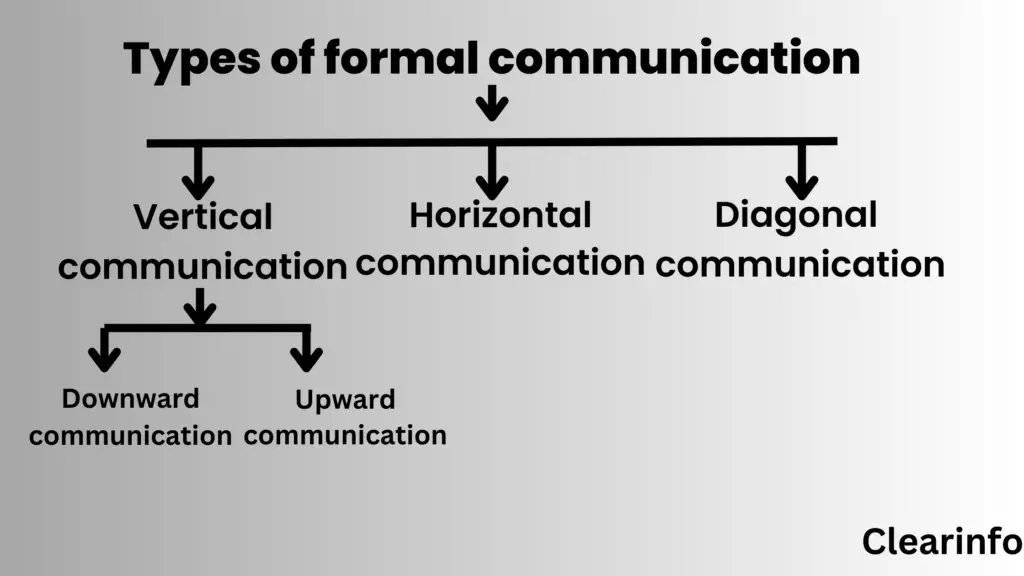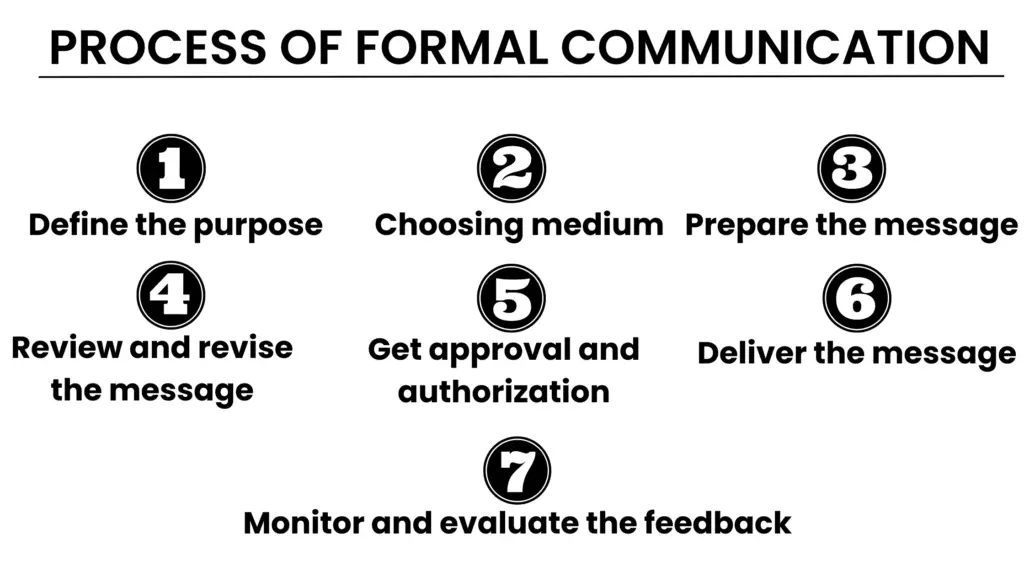One form of communication that is particularly important in professional settings is formal communication. Formal communication is characterized by its official, structured, and professional nature, and follows established rules and protocols.
In this blog, we will delve into the concept of formal communication, exploring what it is, why it’s important, and how it differs from other forms of communication. We will also provide examples of formal communication in various contexts and offer tips for effective formal communication.
Definitions of formal communication
1. According to Herbert Simon, an American economist, and Nobel laureate, “Formal communication is . . communication that takes place through the official channels of an organization and is concerned with the work of the organization.”
2. “Formal communication is a professional method of communication used in the workplace or in business settings, characterized by a clear, concise, and straightforward message conveyed through formal language and structure.” – J. Ashley Panter and William G. Howell, “Business Communication Essentials”
What is formal communication?
Formal communication refers to the official exchange of information within an organization, following predefined channels and protocols. It is systematic, structured, and often documented. This type of communication is essential for transmitting official announcements, reports, and other important information throughout the organization.
Unlike informal communication, which occurs casually and spontaneously, formal communication adheres to established rules and guidelines, ensuring clarity, accuracy, and formality in business interactions. This structured approach helps maintain professionalism and consistency in the spreading of information, contributing to a well-organized and efficient working environment.
Characteristics of formal communication
Formal communication usually follows a specific set of rules and guidelines. Some of the key characteristics of formal communication are:
1) Professional Tone: Formal communication is characterized by a professional and polite tone, and it is designed to convey information clearly and concisely.
2) Pre-defined Structure: Formal communication usually follows a pre-defined structure or format, such as memos, reports, or official letters.
3) Use of Formal Language: Formal communication often involves the use of formal language, which may include technical terms or jargon specific to a particular industry or profession.
4) Impersonal: Formal communication tends to be impersonal, as it focuses on conveying information rather than building relationships.
5) Official Purpose: Formal communication is designed to serve official purposes, such as providing instructions, making requests, or conveying important announcements.
6) Follows Hierarchy: Formal communication usually follows a hierarchical structure, with higher-level managers communicating with lower-level employees.
Examples of formal communication
The following video is an example of formal verbal communication, providing valuable insights into using formal phrases for everyday English conversations.
Here are some common examples of formal communication in the business context:
- Business Emails: Professional emails are widely used for formal communication, including sending project updates, requesting information, or arranging meetings.

- Memos and Reports: Memos and reports are formal documents used to convey information within an organization. They provide detailed insights, analysis, and recommendations on specific topics.
- Official Letters: Official letters, such as cover letters, appointment letters, experience letters, or resignation letters, adhere to formal communication standards. They follow specific formats and contain essential details and instructions.
- Presentations: Formal presentations are used to communicate information to a larger audience. They often involve visual aids, structured content, and a professional delivery style.
Types of formal communication

1) Vertical Communication
Vertical communication takes place hierarchically among different people in an organization. It is most direct, meaning that supervisors communicate with their direct employees or staff and vice versa. On diving deeper, vertical communication can be further divided into two types- upward and downward communication.
A) Upward Communication
Here, the direction in which the formal communication flows is upward. This involves the flow of communication starting from the lower levels of an organization or group and heading toward managers. It includes reviews, reports, and follow-ups. Upward communication mostly facilitates clear feedback in communication within an organization.
Must Read:
What is Upward Communication: Examples, Objectives & Methods
B) Downward Communication
This is one of the forms of vertical communication where the flow is downward, that is starting from a manager or superior toward an employee. The channels of communication could be verbal as well as written here. It could be in the form of instruction, guidance, order, or an announcement. Conversations are usually focused on controlling, directing, and managing such types of communication.
Must read:
Example of vertical communication
Example 1.1
An example of vertical communication involves information being passed from top to bottom and bottom to up.
This includes when orders and instructions are issued by managers to subordinates in the form of vertical downward communication and performance reports/ feedbacks are sent by subordinates to the managers in the form of vertical upward communication.
2) Horizontal Communication
One another type of formal communication is horizontal communication. Here, communication takes place among people who work at the same level of organizational structure. However, they don’t need to belong to the same group. For instance, when managers from different segments of an organization communicate- this would be called horizontal communication.
Examples of horizontal communication
Example 1.1
The head of the marketing and sales department of a manufacturing firm needs to maintain continuous follow of horizontal communication among each other in order to strengthen the sales revenue and brand presence in the market.
Must Read: What Is Horizontal Communication: (Example And Types)
3) Diagonal Communication
Also known as crosswise communication, this type of formal communication takes place within the line of employees belonging to different groups and levels. This means that one has the liberty to communicate with anyone in the organization, irrespective of their level or department. Both formal and informal channels of communication could be used to execute such a flow.
Example of diagonal communication
Example 1.1When a talent acquisition head demands the list of additional manpower requirements from manufacturing department executives.Example 2.1The Operations head sends a message to field supervisors for creating a new standard operating procedure (SOP) for the new line of machinery attached.
Must Read: What Is Diagonal Communication: Examples, Advantages & Features
What is the importance of formal communication?
Formal communication plays a crucial role in various aspects of our personal and professional lives. Here are some reasons why proper communication is essential:
1. Clear and concise communication: Formal communication helps to ensure that messages are conveyed clearly and concisely while following effective communication principles in professional settings.
2. Professionalism: Formal communication adds a level of professionalism to any communication, whether it is a business letter, an email, or a presentation. It conveys a sense of seriousness and respect, which is important in professional relationships.
3. Legal and regulatory compliance: Many organizations that specifically follow formal organizational structures are required to use formal communication to comply with legal and regulatory requirements. For example, certain types of contracts or legal documents require formal language and specific formats.
Related Reading: Difference between formal and informal organization
4. Maintaining records: Formal communication provides a paper trail that can be used for future reference, which can be important in legal, financial, and administrative matters.
5. Consistency: Formal communication helps to ensure that messages are consistent and that everyone is on the same page. This is especially important in organizations where multiple people are involved in decision-making processes.
In summary, formal communication is important because it ensures clarity, professionalism, legal compliance, record-keeping, and consistency in communication.
Related Reading: Advantages and disadvantages of formal communication
What are the different forms of formal communication?
Formal communication can take various forms depending on the context and the purpose. Some common forms of formal communication include:
1) Memos: These are short documents typically used for internal communication within an organization. They are often used to convey information about policy changes, updates on ongoing projects, or to make announcements to staff.
2) Reports: These are detailed documents that are used to provide information on a specific topic. Reports can be used to summarize the findings of research studies, evaluate the performance of an employee or department, or provide updates on the progress of a project.
3) Emails: While emails are often considered a more casual form of communication, they can be used for formal communication as well. Formal emails should use proper salutations and address the recipient respectfully. They can be used to convey information, provide updates, or request information from colleagues or clients.
4) Presentations: Presentations are often used to share information with a larger audience. They can take the form of a slideshow or a speech and are often used to communicate information about a new product, service, or idea.
5) Letters: Formal letters are used for external communication and are typically more formal than memos. They are used to convey information to customers, clients, or other stakeholders. Examples of formal letters include cover letters, business correspondence, and job application letters.
Related Reading: Comparison of formal and informal letter formats
Overall, the form of formal communication chosen will depend on the context and the audience, as well as the purpose of the communication.
What is a formal communication network?
Formal communication networks refer to the established channels of communication that exist within an organization. These networks are typically hierarchical, with information flowing from top management down to lower-level employees.
Formal communication networks can take many forms, including memos, company newsletters, reports, and meetings. They are designed to ensure that important information is disseminated to all organization members in a timely and efficient manner.
Types of formal communication networks
- Circle network: Information in this network, flows in the form of a circle between superiors and subordinates. This network offers two-way communication but often becomes unorganized and confusing.
- Chain network: Information flows in a straight verticle line in a chain network. A superior gives orders to his employee, who further passes them to his subordinate, and the chain goes on in a vertical flow.
- Wheel or Star network: This is the most centralized network where a superior communicates with all his employees but the employees are not connected. The superior is the center of all communication.
- Y-type network: When two subordinates report to a superior together, who further reports to a higher superior, is called a Y-type network of formal communication.
- All-channel network: This is a network where a decentralized type of formal communication takes place. With no central positioning or restrictions, all the members of a group can communicate with each other freely.
Process of formal communication
Formal communication is a type of communication that follows specific protocols and procedures, usually used in professional or business settings. Here is a general process for formal communication:

1. Define the purpose: Identify the reason for the communication and what you want to achieve.
2. Choose the appropriate medium: Select the appropriate communication medium, such as email, letter, memo, report, or meeting, that fits the purpose, audience, and message.
3. Prepare the message: Draft the message, including the content, tone, and structure, that conveys the purpose and meets the formal standards, such as clear and concise language, proper grammar and punctuation, and formal salutations and closings.
4. Review and revise the message: Check the message for accuracy, relevance, completeness, and appropriateness. Revise the message as necessary to ensure it meets the expectations of the audience and the organization.
5. Get approval and authorization: Obtain approval and authorization from the relevant parties, such as supervisors, colleagues, or stakeholders, before sending or presenting the message.
6. Deliver the message: Send or present the message using the chosen medium, following the formal protocols and procedures, such as using the correct format, addressing the recipient correctly, and including any necessary attachments or references.
7. Monitor and evaluate the feedback: Monitor and evaluate the feedback from the recipient or the audience, and adjust the communication as necessary to ensure it meets the desired outcome.
Overall, the process of formal communication involves careful planning, preparation, and execution to ensure effective and professional communication.
Where is formal communication used?
Formal communication is typically used in professional or business settings where there is a need for clear and precise communication that follows a particular set of rules and conventions. Some common examples of where formal communication is used include
#1 Business Correspondence: Formal communication is often used in business correspondence, such as emails, letters, memos, and reports. In such cases, it is essential to maintain a professional tone, use formal language, and adhere to specific formatting guidelines.
#2 Academic Settings: Formal communication is also commonly used in academic settings, such as when writing research papers, theses, and dissertations. The language used is expected to be precise, objective, and based on verifiable facts.
#3 Legal Proceedings: Formal communication is used in legal proceedings, such as when drafting legal contracts, agreements, and other legal documents. The language used in such cases is formal, specific, and precise.
#4 Job Interviews: Formal communication is used during job interviews, where the interviewee is expected to maintain a professional demeanor, speak clearly, and articulate their thoughts in a concise and structured manner.
#5 Government Proceedings: Formal communication is used in government proceedings, such as when drafting laws, regulations, and policies. The language used in such cases is formal, specific, and based on established legal and political conventions.
Formal vs informal communication
Formal and informal communication are two types of communication that differ in terms of structure, language, setting, tone, and purpose. Understanding the differences between formal and informal communication can help individuals communicate effectively in different contexts and situations.
Here’s a table highlighting some key differences between formal and informal communication:
Formal Communication | Informal Communication |
-Follows a prescribed format and structure | -Does not follow a prescribed format or structure |
-Uses standard language and vocabulary | -Uses colloquial or informal language |
-Typically used in professional or official settings | -Typically used in casual or personal settings |
-Often requires written documentation | -Often relies on verbal communication |
-Usually involves a clear hierarchy of authority | -May not involve a clear hierarchy of authority |
-Often involves a professional tone and demeanor | -May involve a more relaxed or informal tone and demeanor |
-Typically focuses on conveying information or making decisions | -May focus on building relationships or socializing |
-Examples: chatting with friends, social media messaging, casual conversations, Gossip network communication |
Related Reading: Informal Communication Advantages And Disadvantages With Example
How to improve formal communication?
Here are some ways to improve formal communication:
- Be clear and concise: Use clear and concise language to convey your message. Avoid using technical jargon or complex sentences that may be difficult to understand.
- Use proper grammar and punctuation: Proper grammar and punctuation are important for conveying your message clearly and effectively. Use spell-check and proofread your communication before sending it.
- Be mindful of your tone: Tone can greatly affect how a message is received. Be mindful of the tone you use, and ensure that it is appropriate for the intended audience and the purpose of the communication.
- Use appropriate formatting: Use appropriate formatting for the type of communication you are using. For example, use headings and bullet points in a report to make it easier to read and understand.
- Use active voice: Use active voice to make your communication more engaging and easier to understand.
- Use examples: Use examples to illustrate your points and make your communication more relatable.
- Ask for feedback: Ask for feedback on your communication to ensure that it is effective and that it has been understood.
- Practice good listening skills: Good communication is a two-way street. Practice good listening skills, such as active listening and asking clarifying questions, to ensure that you understand the message being conveyed to you.
By following these tips, you can improve your formal communication skills and ensure that your messages are clear, concise, and effective.
Important ethics of formal communication
Ethics in formal communication refers to the moral principles and values that guide how individuals and organizations communicate in a professional setting. The following are some ethical considerations that are important to keep in mind when engaging in formal communication:
- Honesty: It is essential to be truthful and transparent in all formal communications. Avoid misleading or misrepresenting information, and be clear about the purpose and intent of your communication.
- Respect: Show respect for your audience by avoiding offensive language or behavior. Be mindful of cultural differences and avoid making assumptions about your audience.
- Privacy: Be mindful of personal information and sensitive data when communicating. Respect individuals’ privacy and ensure that confidential information is protected.
- Fairness: Treat all individuals fairly and equally in your communication. Avoid discrimination, bias, or favoritism.
- Responsibility: Take responsibility for the impact of your communication. Ensure that your messages are accurate and do not harm or mislead your audience.
- Professionalism: Maintain a professional tone and demeanor in your communication. Avoid engaging in personal attacks, offensive language, or unprofessional behavior.
By keeping these ethical considerations in mind, individuals and organizations can promote effective and responsible communication in a formal setting.
Frequently Asked Questions
Q1) What is formal or informal communication?
Ans: Formal communication is a type of communication that adheres to a specific format and structure, employs standard language and terminology, and is generally utilized in official or professional settings. On the other hand, informal communication is a type of communication that doesn’t follow any set format or structure, employs casual or colloquial language, and is generally used in personal or relaxed settings.
Q2) Why is communication formal?
Ans: Communication can be formal or informal, depending on the context and audience. Formal communication is generally used in professional or official settings because it allows for clarity, professionalism, and structure. It helps to ensure that messages are delivered accurately and efficiently, and can also help to establish and maintain a professional reputation.
Q3) Which is the most formal form of communication?
Ans: The most formal form of communication is typically written communication, specifically letters, memos, or emails. Written communication allows for careful crafting of language and precise conveyance of information however merits and demerits of written communication should be checked before drafting the message.
Q4) What is formal communication in the workplace?
Ans: Formal communication in the workplace refers to communication that is official, professional, and follows a set of established rules or protocols. It is often used in business to convey information that is important, sensitive, or legally binding.



